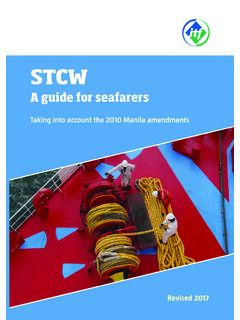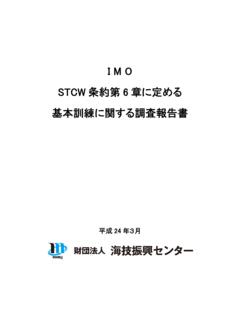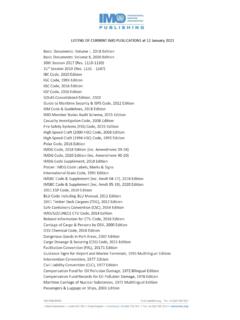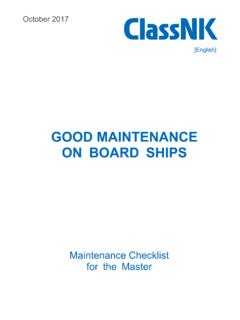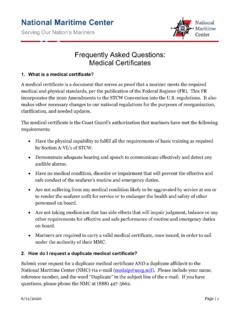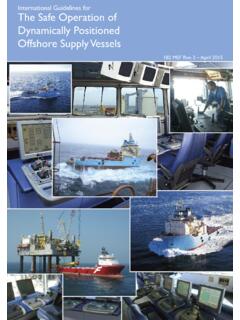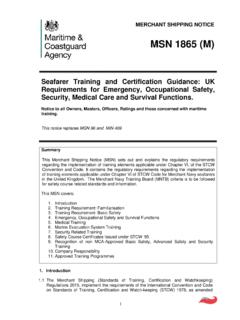Transcription of Shipping Industry Flag State Performance Table
1 Shipping Industry flag State Performance Table 2020/2021. (Including Port State Control Data from 2019/2020). Supported by Shipping Industry flag State Performance Table 2020/2021. Published by Marisec Publications 38 St Mary Axe London EC3A 8BH. Tel: +44 20 7090 1460. Email: Web: Marisec Publications 2021. Supported by Asian Shipowners' Association (ASA) and European Community Shipowners' Association (ECSA). While the advice given in this Guidance has been developed using the best information available, it is intended purely as guidance to be used at the user's own risk. No responsibility is accepted by Marisec Publications or by the International Chamber of Shipping or by any person, firm, corporation or organisation who or which has been in any way concerned with the furnishing of information or data, the compilation, publication or any translation, supply or sale of this Guidance for the accuracy of any information or advice given herein or for any omission herefrom or from any consequences whatsoever resulting directly or indirectly from compliance with or adoption of guidance contained therein even if caused by a failure to exercise reasonable care.
2 The International Chamber of Shipping (ICS) is the global trade association representing national shipowners'. associations from Asia, the Americas and Europe and more than 80% of the world merchant fleet. Established in 1921, ICS is concerned with all aspects of maritime affairs particularly maritime safety, environmental protection, maritime law and employment affairs. ICS enjoys consultative status with the UN International Maritime Organization (IMO) and International Labour Organization (ILO). Purpose 3. There is nothing inherently unusual in Due to the unprecedented nature of the an international ship registry system COVID-19 outbreak, the 2019/2020 flag in which the owner of a ship may be State Performance Table was not published. In order to maintain a complete and located in a country other than the accurate record of Port State Control (PSC). State whose flag the ship flies. However, Performance of flag states in 2019, alongside a balance has to be struck between the this year's Table (2020/2021), we have published the relevant PSC data on the last commercial advantages of selecting page, corresponding to information released a particular flag and the need to in 2019 by the Paris MOU, the Tokyo MOU and the United states Coast Guard (USCG) in their discourage the use of flags that do not respective annual PSC reports.
3 Meet their international obligations. The purpose of this flag State Performance Table How to use the Table is two-fold: This Table summarises factual information in the To encourage shipowners and operators to examine public domain that might be helpful in assessing the whether a flag State has sufficient substance before Performance of flag states . Sources are shown in the using it. footnotes at the end of this report. To encourage shipowners and operators to put Positive Performance indicators are shown as green pressure on their flag Administrations to affect any squares on the Table . improvements that might be necessary, especially in relation to safety of life at sea, the protection of Like all statistics, the Table needs to be used with care. the marine environment, and the provision of decent Where a flag State is missing a single positive indicator, working and living conditions for seafarers. in itself this does not provide a reliable measurement of Performance .
4 For example, a flag State might be unable to ratify a Convention due to conflict with domestic law but might nevertheless implement its main requirements. Equally, a flag State may not be listed on a GREEN squares suggest positive Port State Control white list' because it does not make n . Performance indicators any port calls in that PSC region. RED squares highlight potentially negative n However, if a large number of positive indicators Performance (although individual indicators are shown as being absent, this might suggest that should be considered within the context of Performance is unsatisfactory and that Shipping the Table as a whole). companies should ask further questions of the flag State concerned. The flag State Table and its criteria are not intended to be used for commercial purposes or assessments of the Performance of individual ships that may elect to use a particular flag . It is only intended to encourage shipowners and operators to maintain an open dialogue with their flag Administrations about potential improvements, which may be necessary for enhancement of safety and security of life at sea, protection of the marine environment and provision of decent working conditions for seafarers.
5 Methodology The flag State Performance Table is based on the most up-to-date data available as of January 2021. Port State Control A simple means of assessing the effective enforcement of international rules is to examine the collective Port State Control record of ships flying a particular flag . The three principal Port State Control (PSC) authorities are the countries of the Paris Memorandum of Understanding (MOU), the Tokyo MOU and the United states Coast Guard (USCG). All three authorities target particular flags on the basis of deficiencies and detentions recorded for ships flying that flag . The Table identifies flag states that feature on the Paris and Tokyo MOUs' white lists and that have fully qualified for the USCG's Qualship 21 program, and those which do not appear on their respective black lists/target lists. Ships whose flag states do not appear on PSC white lists' tend to be subject to a greater likelihood of inspections.
6 The Table now also identifies those flags whose ships suffered no detentions within a particular PSC region over the previous three years, but did not meet the relevant minimum requirement of inspections or arrivals to be included in the MOU white lists/ Qualship 21 program. In order to be identified in this way with respect to the Paris and Tokyo MOU white lists, a flag must have undergone at least one inspection in the previous three years. With respect to the Qualship 21 program, a flag must have made at least three distinct arrivals in each of the previous three years. As regards the USCG Target List, flags which incur 2 points on the list are identified with a neutral indicator. This is in alignment with the way in which the three PSC authorities present this information. NB: Flags which do not qualify for Qualship 21 have not been given red squares, as the list of flag states which qualify varies considerably from year to year and non-inclusion is currently not regarded by ICS as an indicator of potentially negative Performance .
7 The full criteria for PSC are explained in the footnotes to the Table . Ratification of major international maritime treaties Ratification of international maritime Conventions does not necessarily confirm whether the provisions of these global instruments are being properly enforced. However, a flag State should be able to provide good reason for not having ratified any of the instruments referred to in the Table . The Table refers to those core' Conventions, relevant to flag State responsibilities, which already enjoy widespread ratification and enforcement. The full criteria for the Conventions listed are shown in the footnotes to the Table . Use of Recognized Organizations in compliance with the IMO RO Code The IMO Code for Recognized Organizations (RO Code) requires flag states to establish controls over ROs conducting survey work on their behalf, and to determine if these bodies have adequate resources for the tasks assigned.
8 The RO Code also requires flag states to submit data to IMO on the ROs authorised to act on their behalf. The Annual Reports released by the Paris and Tokyo MOUs on Port State Control contain Performance Lists of Recognized Organizations', which rank each RO into high-, medium-, low- and very low-performing. Using a combined list of high-performing ROs from the Paris and Tokyo MOU lists, the Table positively identifies flag states which employ as many or more high-performing ROs, as they do non-high-performing ROs, and which have submitted their RO related data to the IMO in line with the RO Code. 5. Age of fleet A high concentration of older tonnage under a particular flag does not necessarily mean that this tonnage is in any way substandard. However, a flag which has a concentration of younger ships may be more likely to attract quality tonnage than a flag State with a high concentration of older vessels. Calculations of Average age' are conducted through the IHS Maritime & Trade Sea-web Database, which is publicly available (subject to subscription).
9 The average age is determined based on analysis of aggregated data of ships registered under a particular flag State . As a positive indicator, the Table therefore shows the 90% of flags (among those listed) that have the lowest average fleet age (the bottom 10% of those listed having the highest average age). Nevertheless, it is strongly emphasised by ICS that the age of an individual ship is not an indicator of quality, and that the condition of an individual ship is ultimately determined by how it is maintained. Reporting requirements There are various reporting requirements concerning the submission of information by flag states to IMO and ILO. Information covering the extent to which flag states actually comply with these reporting requirements is not always available in the public domain. However, as an indicator, the Table positively identifies flags that are in compliance with ILO reporting obligations, as well as flags confirmed by IMO to have communicated information demonstrating that full and complete effect is given to the relevant provisions of the stcw Convention (as amended in 2010 ) and included within the latest stcw .
10 White list', as approved by the IMO Maritime Safety Committee. Attendance at IMO meetings Although in itself not an indicator of their safety and environmental record, flag states that attend the major IMO. meetings (Maritime Safety Committee, Marine Environment Protection Committee and Legal Committee) are thought more likely to be seriously committed to the implementation and enforcement of IMO rules. Attendance at these meetings is also important to keep abreast of regulatory developments. The Table identifies flag states that have been represented at all meetings of these three major IMO committees, plus the biennial meeting of the IMO Assembly, during the two years previous to 1 January 2021. IMO Member State Audit When governments accept to be bound by an IMO Convention they tacitly agree to incorporate it into their national law, implement it and enforce its provisions. The IMO Audit Scheme determines how effectively audited states adhere to all applicable mandatory IMO instruments covered by the Scheme.





